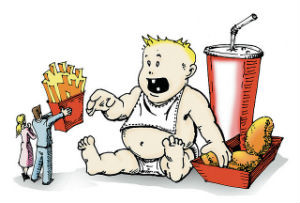Health Foods And Childhood Obesity
According to the Centers for Disease Control and Prevention (CDC), child and adolescent obesity in America has doubled and quadrupled since 1980. A number of initiatives have been launched at the local and state levels in the United States to try to force good and nutritious meals on customers by regulating fast food. Although these stop-gaps may help to slow or reverse the rising obesity trend, it is ultimately up to parents to provide their children with a portion-controlled, balanced diet.
The “McHealthy Meal?”
Last year, a member of the New York City council attempted to impose dietary criteria on fast food companies that provide meals to youngsters. The motion stipulated that meals should not exceed 500 calories, with fat calories limited to 35 percent of the meal, added sugar or saturated fat at less than 10% of the calories, and total salt at less than 600 mg each meal. A dish of fruit, vegetables, or healthy grains would be required for these meals advertised to children with toys.
The main issue with regulatory schemes like this bill is that they are not supported as remedies to the problem by first-time buyers. Although the new meal standards have the potential to reduce salt consumption by 10% and calories by 9%, this is only provided parents purchase the meals and do not skip them entirely. That’s precisely what researchers discovered after examining receipts from over 300 transactions and 400 lunches. The majority of the meals exceeded the meal standards, but the issue of parents buying adult meals for their children is even more glaring. These adult portions, which are not regulated, are most likely to blame for the growing tide of childhood obesity.
A Two-Fold Issue
Diet and exercise are the major problems with childhood obesity, just as they are with adults. Most weight gain has a remedy that can be achieved by either broad-scale regulation or a complete shift in how parents are educated about their children’s requirements.
It is advised that children and teenagers aged 6 to 17 engage in at least 60 minutes of daily physical exercise. This physical exercise is a two-pronged method that helps the body grow and modify its own metabolism, managing weight naturally and lowering stress and anxiety, all of which assist to prevent overeating. In 2013, just 27% of high school students exercised on a daily basis.
The American children’s diet, on the other hand, is a mixed bag. Children’s diets should be abundant in fruits, vegetables, whole grains, and low-fat dairy products, with solid fats, cholesterol, added sugars, salt, and refined grains being limited. However, the majority of youngsters do not have access to a nutritious food. This inadequate diet leads to an energy imbalance, which increases the risk of juvenile obesity and overweight problems.

The diet of the American child fails to meet the following recommendations:
- 2.5-6.5 cups of fruits and vegetables daily
- 2-3 ounces of whole grains
- limit sodium intake to 1500-2300 mg daily
However they do:
- eat or drink empty calories to the tune of 40% of their diet from soda, desserts, pizza, fruit drinks and whole milk
A Dual Solution
Every day, it becomes evident that the actual answer to this ever-increasing problem is to begin imposing regulatory dietary changes on parents at every opportunity, as well as to encourage improved parental education in terms of food and activity for their children.
Some of the most recent modifications should be included under regulatory revisions, but on a nationwide basis. Limit the calorie content of “fast-food” meals for children, or tax them to make them more expensive than a healthier option. All elementary and high school campuses should be free of unhealthy sweets and drinks, and healthy alternatives should be available.
Any kid with a BMI above a specific level should be required to participate in diet and exercise parental education programs to ensure that they are making the best choices possible. This problem can only be solved if parents and society work together to solve it.







